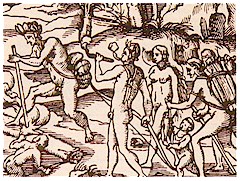The Cuban aboriginal population
- Submitted by: admin
- Editorial Articles
- History
- 11 / 12 / 2006

According to historical calculations, the population of the island was about of 300 thousand Indians when Spaniards arrived to Cuba. The aboriginal population was divided into three ethnic groups: Guanahatabeyes, Siboneyes and Taínos. The latest were the ceramists.
Climate and geographical conditions favored a peaceful life at that time. There was plentiful food, no dangerous animals and one or two hurricanes from which they were sheltered in their caves.
The Guanahatabeyes were the least developed of all ethnic groups forming the Cuban aboriginal culture. When Spaniards arrived, they were settled at the far western part of the country in the territory of todays Pinar del Río, specifically at the San Antonio cape.
This group was the most primitive of all. They did not have houses, seats, neither towns nor farming. They only used to eat the meat they just found in the woodland as well as turtle and fish. Some of their tools found like vessels, hammers, conch ornaments and the gouge of shells are in todays excavations.
The Siboneyes were the most developed ones. They obtained symmetric forms and a better finish of their different tools. Their row materials were generally shells or stones used to make mortars, hammers, pestles, spoons and cutting tools.
This community was located mainly at the northern part of todays Villa Clara and the cays. In addition, at the Jardines de la Reina archipelago and at the central eastern part up to the Gulf of Guacanayabo. However, from the archeological point of view, historians ascribe a general presence through the whole country. They were essentially anglers.
The Taínos came from the neighboring La Española island. They were settled in the central and eastern part of the country. They fostered agriculture and pottery achieving great development.
They had small and well-organized settlements. They were structured by either caneyes or bohíos. The cacique was considered the highest authority. The work was equally divided. Men were in charge of hunting and fishing while women worked in the agriculture. The latest also worked in the pottery production. They developed the basketwork and the rope making.
Slavery, slaughters, massive suicides, massive emigration to close islands and cays as well as some unknown diseases then, eventually, made the Cuban aboriginal population to disappear.
Comments